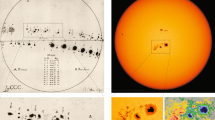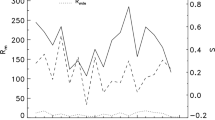Abstract
Two features are found in the modern era sunspot record (cycles 10–22: ca. 1850-present) that may prove useful for gauging the size of cycle 23, the next sunspot cycle, several years ahead of its actual onset. These features include an inferred long-term increase against time of maximum amplitude (RM, the maximum value of smoothed sunspot number for a cycle) and the apparently inherent differing natures of even- and odd-numbered sunspot cycles, especially when grouped consecutively as ‘even-odd’ cycle pairs. Concerning the first feature, one finds that 6 out of the last 6 sunspot cycles have had RM ≥ 110.6 (the median value for the modern era record) and that 4 out of 6 have had RM > 150. Presuming this trend to continue, one anticipates that cycle 23 will likewise have RM ≥ 110.6 and, perhaps, RM > 150. Concerning the second feature, one finds that, when one groups sunspot cycles into consecutively paired even-odd cycles, the odd-following cycle has always been the larger cycle, 6 out of 6 times. Because cycle 22 had RM = 158.5, one anticipates that cycle 23 will have RM > 158.5. Additionally, because the average ‘difference’ between RM(odd) and RM(even) for consecutively paired even-odd cycles is 40.3 units (sd = 14.2), one expects cycle 23 to have RM ≥ 162.3 (RM = 198.8 ± 36.5 at the 95% level of confidence). Further, because of the rather strong linear correlation (r = 0,959, se = 13.5) found between RM(odd) and RM(even) for consecutively paired even-odd cycles, one infers that cycle 23 should have RM ≥ 176.4 (RM = 213.9 ± 37.5 at the 95% level of confidence). Since large values of RM tend to be associated with fast rising cycles of short ascent duration and high levels of 10.7-cm solar radio flux, cycle 23 is envisioned to be potentially one of the greatest cycles of the modern era, if not the greatest.
Similar content being viewed by others
References
Bahcall, J. N. and Press, W. H.: 1991, Astrophys. J. 370, 730.
De Jager, C.: 1959, in S. Flügge (ed.), Encyclopedia of Physics, Vol. LII, Astrophysics III: The Solar System, Springer-Verlag, Berlin, p. 150.
Everitt, B. S.: 1977, The Analysis of Contingency Tables, John Wiley and Sons, New York.
Friis-Christensen, E. and Lassen, K.: 1991, Science 254, 698.
Gnevyshev, M. N. and Ohl, A. I.: 1948, Astron. Zh. 25, 18.
Gorney, D. J.: 1989, J. Spacecraft Rockets 26, 428.
Gorney, D. J.: 1990, Rev. Geophys. 28, 315.
Hale, G. E. and Nicholson, S. B.: 1938, Publ. Carnegie Inst., No. 498.
Howard, R.: 1977, in A. Bruzek and C. J. Durrant (eds.), Illustrated Glossary for Solar and Solar-Terrestrial Physics, Vol. 69, Astrophysics and Space Science Library, D. Reidel Publ. Co., Dordrecht, Holland, p. 7.
Kelly, P. M. and Wigley, T. M. L.: 1990, Nature 347, 460.
Krauss, L. M.: 1990, Nature 348, 403.
Kurth, W. S.: 1991, Nature 353, 705.
Lapin, L. L.: 1978, Statistics for Modern Business Decisions (2nd ed.), Harcourt Brace Jovanovich, Inc., New York.
Layden, A. C., Fox, P. A., Howard, J. M., Sarajedini, A., Schatten, K. H., and Sofia, S.: 1991, Solar Phys. 132, 1.
McKinnon, J. A.: 1987, Report UAG-95, World Data Center A for Solar-Terrestrial Physics, Boulder, Colorado, 112 pp.
Rabin, D. M., De Vore, C. R., Harvey, K. L., Hoeksema, J. T., and Sheeley, N. R., Jr.: 1990, NOAO Preprint No. 352, NOAO, Tucson, Arizona, 77 pp.
Reid, G. C.: 1991, J. Geophys. Res. 96, 2835.
Vampola, A. L.: 1989, J. Spacecraft Rockets 26, 416.
Vitinskii, Yu. I.: 1965, Solar Activity Forecasting, NASA TT F-289, Washington, D. C., 129 pp.
Waldmeier, M.: 1961, The Sunspot-Activity in the Years 1610–1960, Schultness and Co., Zürich.
Walterscheid, R. L.: 1989, J. Spacecraft Rockets 26, 439.
Willson, R. C.: and Hudson, H. S.: 1991, Nature 351, 42.
Wilson, R. M.: 1987a, J. Geophys. Res. 92, 10101.
Wilson, R. M.: 1987b, Solar Phys. 111, 255.
Wilson, R. M.: 1987c, Solar Phys. 112, 1.
Wilson, R. M.: 1988a, Solar Phys. 115, 397.
Wilson, R. M.: 1988b, Solar Phys. 117, 179.
Wilson, R. M.: 1988c, Solar Phys. 117, 269.
Wilson, R. M.: 1988d, J. Geophys. Res. 93, 10011.
Wilson, R. M.: 1989, NASA Tech. Paper 2948, NASA, Marshall Space Flight Center, Huntsville, Alabama, 54 pp.
Wilson, R. M.: 1990a, Solar Phys. 125, 133.
Wilson, R. M.: 1990b, Solar Phys. 125, 143.
Wilson, R. M.: 1990c, Solar Phys. 127, 199.
Withbroe, G. L.: 1989, J. Spacecraft Rockets 26, 394.
Author information
Authors and Affiliations
Rights and permissions
About this article
Cite this article
Wilson, R.M. An early estimate for the size of cycle 23. Sol Phys 140, 181–193 (1992). https://doi.org/10.1007/BF00148438
Received:
Revised:
Issue Date:
DOI: https://doi.org/10.1007/BF00148438




